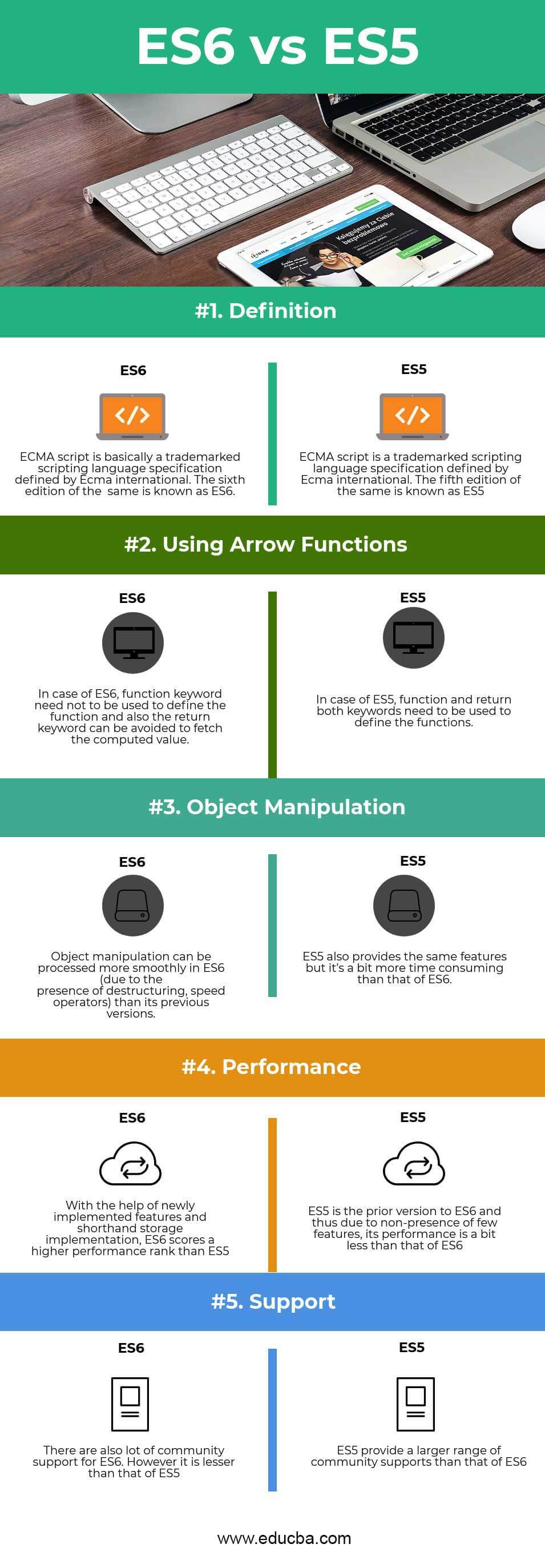
Difference Between ES6 vs ES5
ES6 vs ES5 are two of the important scripting languages in the Software Development industry. Both ES5 vs ES6 have some similarities in nature, but at the same point in time, there are also many difference between ES6 and ES5. Here, we will be going to have a detailed discussion on ES6 vs ES5.
The full form of ES is ECMA Script which is basically a trademarked scripting language defined by ECMA International. This is mainly used for client-side scripting on the World Wide Web. The first edition of the ECMA Script was published in June 1997.
The sixth version of ECMA Script is known as ES6 (it is also called as ECMA Script 2015).
Features of ES6 an ES5
The ES6 includes the following important features:
ES6 Features
- Arrows: These are a function which is described by the ‘=>’ syntax
- Objects: Object literals are used to support prototype assignments.
- Classes: ES6 classes can be easily implemented over the prototype-based object-oriented pattern
- Destructing: It allows binding pattern, which is based primarily on pattern matching.
- String interpolation
- Default
- Spread
- Module Loaders
- Weak set
- Map
- New Library
- Promises
- Proxies
The fifth edition of the ECMA Script is known as ES5 and ECMA Script 2009. The ES5 includes the following important features:
ES5 Features
1.Strict Mode: It basically helps javascript languages to perform more efficiently by applying more checks and cleaning a few existing features
2.Accessors: It allows users to implement the getting and setting of properties by using methods.
3.Syntactical changes:
- Trailing Commas
- Multiline string literals
- Property keys using reserved words
4. Additional features: A few additional new features have been introduced in case ES5.
a. Metaprogramming: Different prototypes are used for the same
- Object.getPrototypeOf()
- Object.create()
- Object.defineProperty()
- Object.keys()
- Object.seal()
- Object.freeze() etc.
b. New Methods:
- String.prototype.trim()
- Array.isArray()
- Array.prototype.indexOf()
- Array.prototype.map()
c. Usage of Bracket Operator
d. JSON:
- JSON.parse()
- JSON.stringify()
e.Built-in objects that are specific to JSON:
- Boolean.prototype.toJSON()
- Number.prototype.toJSON()
- String.prototype.toJSON()
Pros and Cons
Like two sides of a coin, both ES6 vs ES5 has a few pros and cons.
ES6 Pros:
- The tail call optimization feature has been enabled in the case of ES6 implementation.
- In the case of ES6, the function keyword need not be used to define the function, and the return keyword can also be avoided to fetch the computed value.
- String templates and handle interpolation can be used more maturely while implementing the scripts using this language.
- Shorthand syntax for object literals can be used with this scripting language.
- Using this version, the core codes can be represented in a cleaner syntactical way.
ES6 Cons:
- For the support and networking perspective, it lacks a little bit while compared to that of ES5.
- From the browser support and runtime comparison perspective, sometimes it laps slightly while undergoing heavy object loads.
- It sometimes creates a little confusion over the best and standard coding practices.
- It may appear a little bit tricky from the learning perspective while compared to the normal java scripts.
ES5 Pros:
- Using ES5, a user would be able to implement the property access arrays [] features on strings
- Reserved words can use as property names.
- It supports and process the implementation of multiline string literals
- Using this version, the core codes can be represented in a cleaner syntactical way
- All the functions and their corresponding usage can be clearly described with this version
ES5 Cons:
- The new features that have been implemented in ES6 are mostly not present in ES5.
- It sometimes creates a little confusion over the best and standard coding practices.
- It may appear a little bit tricky from the learning perspective while compared to the normal java scripts.
Head to Head Comparison Between ES6 and ES5 (Infographics)
Below is the top 5 difference between ES6 and ES5:
Key differences between ES6 vs ES5
Both ES6 vs ES5 are popular choices in the market; let us discuss some of the major Difference Between ES6 vs ES5:
- Import statement feature is present as a part of this newly implemented ECMA Script version 6, whereas this is not the case with ES5.
- Asynchronous functions and generators can be used as part of a new feature in the case of ES6.
- From the support perspective, ES5 provides more support than that of ES6.
- In case of ES6, “const” and “let” keywords can be used with respect to immutable and block scripting objects, whereas this is not present in ES5.
ES6 and ES5 Comparison Table
The primary comparison between ES6 and ES5 are discussed below:
| Basis of Comparison Between ES6 vs ES5 |
ES6 |
ES5 |
| Definition | ECMA script is basically a trademarked scripting language specification defined by Ecma international. The sixth edition of the same is known as ES6. | ECMA script is a trademarked scripting language specification defined by Ecma international. The fifth edition of the same is known as ES5. |
| Using Arrow Functions | In the case of ES6, the function keyword need not be used to define the function and also, the return keyword can be avoided to fetch the computed value. | In the case of ES5, function and return, both keywords need to be used to define the functions. |
| Object Manipulation | Object manipulation can be processed more smoothly in ES6 (due to the presence of destructuring, speed operators) than in its previous versions. | ES5 also provides the same features, but it’s a bit more time consuming than that of ES6. |
| Performance | With the help of newly implemented features and shorthand storage implementation, ES6 scores a higher performance rank than ES5. | ES5 is the prior version to ES6, and thus, due to the non-presence of a few features, its performance is a bit less than that of ES6 |
| Support | There is also a lot of community support for ES6. However, it is lesser than that of ES5. | ES5 provide a larger range of community supports than that of ES6 |
Conclusion
After comparing ES5 vs ES6 over a range of factors, it can be concluded that these are the two major scripting languages, and ES6 is the newer version between them, but at the same point in time, ES6 vs ES5 has its own pros and cons. Thus, based on the type of project need, time of work, and all other discussed aspects, ES6 vs ES5 should be selected to reach the desired goal.
Recommended Articles
This has been a guide to the top difference between ES6 and ES5. Here we have discussed ES6 and ES5 head to head comparison, key differences, and infographics and comparison table. You may also have a look at the following articles–


